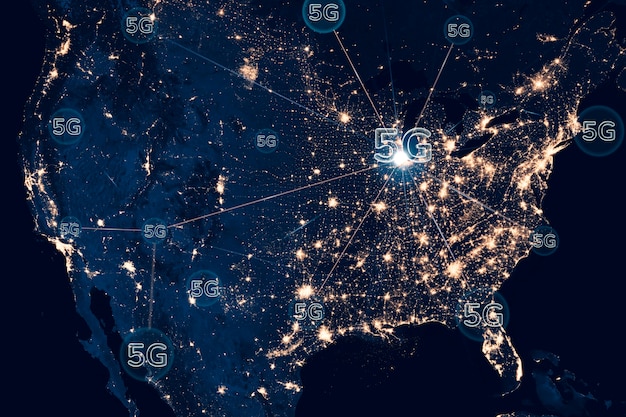How 5G Network Slicing Will Transform US Industries by 2025

5G network slicing is poised to revolutionize US industries by 2025 by enabling customized network capabilities that cater to specific industry needs, enhancing efficiency, security, and innovation across sectors like healthcare, manufacturing, and transportation.
The advent of 5G network slicing promises a transformative impact on various sectors across the United States by 2025. But what exactly is network slicing, and how will it reshape industries ranging from healthcare to manufacturing?
Understanding 5G Network Slicing
5G network slicing is a revolutionary technology that allows mobile operators to create multiple virtual networks within a single physical 5G infrastructure. Each slice is customized to provide specific network capabilities, such as bandwidth, latency, security, and reliability, tailored to the needs of different applications and industries.
The Core Concept of Network Slicing
Network slicing is akin to having multiple dedicated networks operating on a single platform. This ensures that each industry receives the precise network resources it requires, optimizing performance and efficiency.
Key Benefits of Network Slicing
- Reduced latency for critical applications.
- Enhanced security through isolated network segments.
- Optimized bandwidth allocation for data-intensive tasks.
- Increased reliability for essential services.

This customization allows industries to leverage 5G technology in ways that were previously unattainable, driving innovation and creating new business opportunities. Network slicing is not just about faster speeds; it’s about smarter, more adaptable connectivity.
Healthcare Revolutionized by 5G Slicing
The healthcare industry stands to gain significantly from 5G network slicing, enabling advancements in telemedicine, remote patient monitoring, and real-time data analysis. These enhancements will improve patient outcomes and streamline healthcare delivery.
Telemedicine Advancements
With network slicing, telemedicine consultations can be conducted with minimal latency and high reliability, ensuring seamless communication between doctors and patients, regardless of location.
Remote Patient Monitoring
5G slicing enables continuous monitoring of patients’ vital signs and health data, allowing healthcare providers to detect anomalies early and intervene promptly, reducing hospital readmissions and improving overall patient care.
Network slicing ensures that critical healthcare applications receive priority bandwidth and security, guaranteeing the integrity and confidentiality of patient data. This enhances the trust and reliability of digital healthcare solutions.
Manufacturing Enhanced by 5G Slicing
In the manufacturing sector, 5G network slicing will drive automation, improve production efficiency, and enable real-time monitoring of equipment and processes. This will lead to increased productivity and reduced operational costs.

Smart Factories
Network slicing enables the creation of smart factories where machines, sensors, and control systems communicate seamlessly, optimizing production processes and minimizing downtime.
Real-Time Monitoring
5G slicing allows manufacturers to monitor equipment performance in real-time, identify potential issues before they escalate, and implement predictive maintenance strategies, reducing disruptions and extending the lifespan of machinery.
The ability to allocate specific network resources to different manufacturing processes ensures that critical operations are not affected by network congestion or latency. This leads to more efficient and reliable production cycles.
Transportation Transformed by 5G Slicing
The transportation industry will experience a significant transformation through 5G network slicing, with applications ranging from autonomous vehicles to smart traffic management systems. These advancements will enhance safety, reduce congestion, and improve overall transportation efficiency.
Autonomous Vehicles
Network slicing provides the low latency and high reliability required for autonomous vehicles to communicate with each other and with infrastructure, enabling safe and efficient navigation.
Smart Traffic Management
5G slicing allows for real-time monitoring of traffic conditions, enabling dynamic adjustments to traffic flow and reducing congestion. This leads to shorter commute times and improved air quality.
The enhanced connectivity provided by network slicing ensures that transportation systems operate smoothly and safely. This includes enhanced communication between vehicles, infrastructure, and control centers.
Financial Services and 5G Network Slicing
The financial services sector is set to benefit from 5G network slicing by bolstering security, speeding up transaction times, and improving customer experiences. This will allow for more efficient and secure financial operations.
Enhanced Security
Network slicing enables the creation of secure, isolated networks for financial transactions, reducing the risk of cyberattacks and data breaches.
Faster Transactions
5G slicing provides the low latency required for real-time financial transactions, ensuring that payments and transfers are processed quickly and efficiently.
- Improved fraud detection through real-time data analysis.
- Secure mobile banking with enhanced encryption.
- Efficient high-frequency trading with minimal latency.
The enhanced security and speed provided by network slicing will enable financial institutions to offer more innovative and reliable services to their customers, driving growth and competitiveness.
Challenges and Opportunities in 5G Slicing Deployment
While 5G network slicing presents numerous opportunities, its deployment also faces several challenges, including technical complexities, regulatory hurdles, and the need for industry collaboration. Overcoming these challenges is crucial for realizing the full potential of network slicing.
Technical Complexities
Implementing network slicing requires advanced network management and orchestration capabilities. Operators need to invest in new technologies and develop the expertise to manage multiple virtual networks effectively.
Regulatory Hurdles
Clear and consistent regulatory frameworks are needed to ensure fair competition and prevent anti-competitive practices. Policymakers need to work with industry stakeholders to develop regulations that promote innovation and protect consumers.
However, the opportunities outweigh the challenges. By addressing these issues proactively, the US can position itself as a leader in 5G network slicing and reap the economic benefits of this transformative technology.
| Key Point | Brief Description |
|---|---|
| 🚀 5G Network Slicing | Virtual networks on a single physical infrastructure |
| 🏥 Healthcare | Enables telemedicine and remote monitoring |
| 🏭 Manufacturing | Drives automation and real-time monitoring |
| 🚗 Transportation | Transforms with autonomous vehicles and smart traffic systems |
Frequently Asked Questions
5G network slicing is the creation of multiple virtual networks on a single physical 5G infrastructure. Each slice is customized to meet the specific requirements of different applications and industries.
It enables advancements in telemedicine, remote patient monitoring, and real-time data analysis, improving patient outcomes and streamlining healthcare delivery with enhanced security and reliability.
It will drive automation, enhance production efficiency, and enable real-time monitoring of equipment and processes, leading to increased productivity and reduced operational costs in smart factories.
It will enable autonomous vehicles, smart traffic management systems, and improved communication between vehicles and infrastructure, enhancing safety and reducing congestion on the roads.
Challenges include technical complexities in network management, regulatory hurdles requiring consistent frameworks, and the need for industry collaboration to standardize and optimize network deployment efficiently.
Conclusion
5G network slicing is poised to revolutionize US industries by 2025, offering customized network capabilities that enhance efficiency, security, and innovation across various sectors. By addressing the associated challenges and fostering collaboration, the US can unlock the full potential of this transformative technology.





